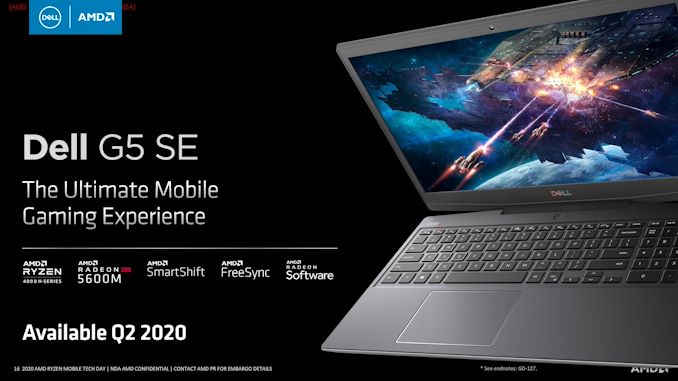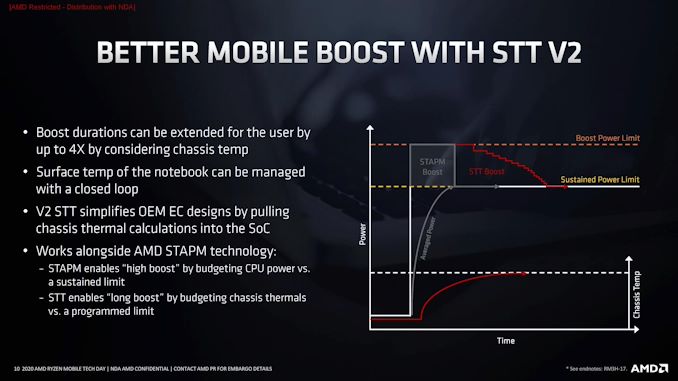AMD Details Renoir: The Ryzen Mobile 4000 Series 7nm APU Uncovered
by Dr. Ian Cutress on March 16, 2020 11:00 AM ESTAMD SmartShift
We’ve covered AMD’s SmartShift before, when it was announced at CES, as a technology that allows a system management controller to interact with both the mobile APU and an AMD graphics card in the same system in order to shift power where it is needed. This solution is still based on separate power rails between the two, however the use of the scalable control fabric (SCF) part of Infinity Fabric means that parts of the APU and parts of the GPU can interact together in this way. Ultimately AMD believes they can score 10-12% better on heavy CPU workloads like CineBench or gaming workloads like The Division.
The solution is firmware based, but requires interaction between qualified hardware. AMD states that often in these sorts of CPU+GPU designs, while the chassis has a total design TDP, if one of the elements of the system is idle, then the other can’t take advantage of the extra turbo headroom available. SmartShift aims to fix that.
What’s new here is that AMD is primarily focus will be on Ryzen Mobile 4000 + Vega 10 style systems. The first one with SmartShift enabled will be the Dell G5 SE. The Dell G5 SE is being labelled as ‘the ultimate mobile gaming experience’, and will feature a new H-series processor, the Radeon RX 5600M, SmartShift, FreeSync, and have a 15-inch display. The unit will be coming out in Q2.
System Temperature Tracking (Version 2)
SmartShift is also part of a new System Temperature Tracking paradigm that AMD is implementing in its new APUs. Even if there is power headroom, a system can’t turbo if there isn’t thermal headroom. Smart Temperature Tracing v2 (or STTv2) is designed to help a system boost for longer by knowing more about the thermal profile of the device.
My placing additional thermal probes inside the system, such as on hot controllers or discrete GPUs, the readings of these can be passed through the Infinity Fabric to an embedded management controller. Through learning how the system thermals interact when different elements are loaded, the controller can determine if the system still has headroom to stay in turbo for longer than the current methodology (AMD’s Skin Temperature Aware Power Management). This means that rather than having a small number of sensors getting a single number for the temerpature of the system, AMD takes in many more values to evaluate a thermal profile of what areas of the system are affected at what point.
What STTv2 does at the end of the day is potentially extend the boost time for a given system, depending on its thermal capabilities. For example, the Lenovo Yoga Slim 7 which we are expecting for review only has a 15 W processor inside, but the chassis has been built for a 25 W TDP design, which means that STTv2 should kick in and provide the user with peak performance for longer.














95 Comments
View All Comments
Teckk - Monday, March 16, 2020 - link
This supports Thunderbolt 3?Ian Cutress - Monday, March 16, 2020 - link
If the OEM uses a TB3 controllerBradEK - Monday, March 16, 2020 - link
Page 2, under What's New: "Compared to the precious generation of Zen mobile processors". Previous?Fataliity - Monday, March 16, 2020 - link
It's amazing how much higher density they are at now. Hopefully this is a sign of things to come. (62.82 for Renoir, vs 52 for Zen2, vs 40.5 for Navi). Anyone who says you won't gain any "node shrink" advantage staying on 7nm, doesn't realize how much room is still left.maroon1 - Monday, March 16, 2020 - link
I rather see some real tests instead of slidesPeachNCream - Monday, March 16, 2020 - link
You will have to wait until products are available for testing.senttoschool - Monday, March 16, 2020 - link
You don't say?Holliday75 - Monday, March 16, 2020 - link
I believe he did.Zizo007 - Monday, March 16, 2020 - link
4900H 4.4Ghz boost. That should beat any mobile Intel CPU including upcoming 10th gen. I wonder how strong the iGPU is? 1080p medium gaming? If it is, I might buy one for portable gaming and good battery life. I don't like laptop dGPU, I have one and it KILLS the battery.milkywayer - Monday, March 16, 2020 - link
I would love to see an xps 13 based on this cpu. Assuming amd manages to beat Intel on mobile efficiency finally.